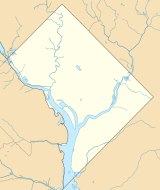Getting Realistic by Using Gray and Green Infrastructure in D.C.
Background

Under a 2005 consent decree, DC Water was permitted to evaluate green infrastructure as an alternate or supplement to gray infrastructure controls in the Rock Creek and Potomac River drainage areas. In 2016, EPA, the District of Columbia, and DC Water agreed to modify the 2005 consent decree to include an aggressive green infrastructure implementation plan across those major sewersheds. To understand if such large-scale green infrastructure could meet consent decree requirements in a highly urban area, DC Water conducted feasibility studies within the Rock Creek and Potomac sewersheds, evaluating infrastructure performance and costs. DC Water determined that they would need to use a flexible approach with both gray and green infrastructure to achieve the modified long-term control plan (LTCP) requirements.
DC Water has made major investments to advance the state of green infrastructure in its city and has showcased through their feasibility studies how to methodically evaluate incorporating green infrastructure successfully in a community. As of 2020, DC Water had spent more than $80 million on green infrastructure initiatives and projects.
Quantitative Results
Rock Creek Sewershed. After publishing the feasibility study for the Rock Creek sewershed in 2020, DC Water and EPA agreed that a "hybrid approach," or a combination of gray and green infrastructure, is most practical to achieve the modified LTCP goals. By 2030, DC Water will manage runoff from 30 percent of the total impervious acres in the sewershed using green infrastructure. DC Water has completed Rock Creek Project 1, which constructed 19 acres of green infrastructure including 36 bioretention planters, two curb extension bioretention areas, eight parking lane permeable pavement projects, and 31 alley permeable pavement projects. Collaborative projects in the community also contributed to green infrastructure achievements, including Green Alley Partnership and downspout disconnection efforts. The green infrastructure from these projects manages runoff from the approximately 20 impervious acres. Another Rock Creek project is currently in the planning phase, to be completed by 2024. It will manage an additional 22 impervious acres with green infrastructure and includes 48 permeable alleys and 28 bioretention planters.
Potomac River Sewershed. DC Water completed the Potomac River Project A in 2019, which consists of eight constructed acres of green infrastructure including five bioretention planters adjacent to the roadways, and 15 parking lane permeable pavement projects. Additional collaborative projects completed include 23 alleys with permeable pavement through the Green Alley Partnership and downspout disconnection efforts. These Potomac River sewershed green infrastructure projects manage runoff from 44 impervious acres.
Lessons Learned
Feasibility studies provided valuable information and data to the community and informed the consent decree modification that enabled DC Water to effectively combine green with gray infrastructure to meet both community goals and regulatory requirements.
